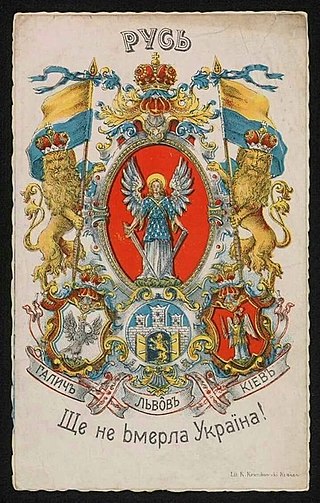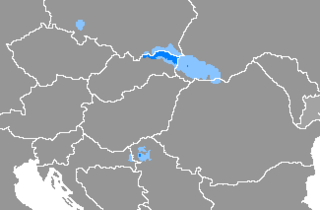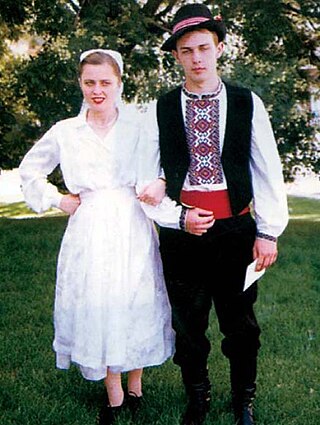
Ruthenia is an exonym, originally used in Medieval Latin as one of several terms for Kievan Rus', the Kingdom of Galicia-Volhynia and, after their collapse, for East Slavic and Eastern Orthodox regions of the Grand Duchy of Lithuania and the Kingdom of Poland, corresponding to what is now Ukraine and Belarus.

Rusyn, is an East Slavic language spoken by Rusyns in parts of Central and Eastern Europe, and written in the Cyrillic script. Within the community, the language is also referred to by the older folk term, руснацькый язык, rusnac'kyj jazyk, 'Rusnak language', or simply referred to as speaking our way. The majority of speakers live in an area known as Carpathian Ruthenia that spans from Transcarpathia, westward into eastern Slovakia and south-east Poland. There is also a sizeable Pannonian Rusyn linguistic island in Vojvodina, Serbia, as well as a Rusyn diaspora throughout the world. Per the European Charter for Regional or Minority Languages, Rusyn is officially recognized as a protected minority language by Bosnia and Herzegovina, Croatia, Hungary, Romania, Poland, Serbia, and Slovakia.

Ruthenian and Ruthene are exonyms of Latin origin, formerly used in Eastern and Central Europe as common ethnonyms for East Slavs, particularly during the late medieval and early modern periods. The Latin term Rutheni was used in medieval sources to describe all Eastern Slavs of the Grand Duchy of Lithuania, as an exonym for people of the former Kievan Rus', thus including ancestors of the modern Russians, Ukrainians and Belarusians. The use of Ruthenian and related exonyms continued through the early modern period, developing several distinctive meanings, both in terms of their regional scopes and additional religious connotations.

Carpathian Ruthenia is a historical region on the border between Central and Eastern Europe, mostly located in western Ukraine's Zakarpattia Oblast, with smaller parts in eastern Slovakia and the Lemko Region in Poland.

Lemkos are an ethnic group inhabiting the Lemko Region of Carpathian Rus', an ethnographic region in the Carpathian Mountains and foothills spanning Ukraine, Slovakia and Poland.

The Boykos, or simply Highlanders, are an ethnolinguistic sub-group of Rusyns located in the Carpathian Mountains of Ukraine, Slovakia, Hungary, and Poland. Along with the neighboring Lemkos and Hutsuls, the Boykos speak a dialect of the Rusyn language. Within Ukraine, the Boykos and other Rusyns are seen as a sub-group of ethnic Ukrainians. Boykos differ from their neighbors in dialect, dress, folk architecture, and customs.

Rusyns, also known as Carpatho-Rusyns, or Rusnaks, are an East Slavic ethnic group from the Eastern Carpathians in Central Europe. They speak Rusyn, an East Slavic language variety, treated variously as either a distinct language or a dialect of the Ukrainian language. As traditional adherents of Eastern Christianity, the majority of Rusyns are Eastern Catholics, though a minority of Rusyns still practice Eastern Orthodoxy. Rusyns primarily self-identify as a distinct Slavic people and they are recognized as such in Croatia, Hungary, Poland, Romania, Serbia, and Slovakia, where they have official minority status. Alternatively, some identify more closely with their country of residence, while others are a branch of the Ukrainian people.

The Ruthenian Greek Catholic Church, also known in the United States simply as the Byzantine Catholic Church, is an Eastern Catholic church that uses the Byzantine Rite for its liturgies, laws, and cultural identity. It is one of the 23 sui juris Eastern Catholic churches that are in full communion with the Holy See and the rest of the Catholic Church. There are significant, culturally distinct communities in the United States, Canada, and Europe. In the United States, the Byzantine Catholic Metropolitan Church of Pittsburgh is self-governing. In Europe, Ruthenian jurisdictions are exempt, i.e. dependent directly on the Holy See. The European branch has an eparchy in Ukraine and another in the Czech Republic.

The Hutsuls are an East Slavic ethnic group spanning parts of western Ukraine and Romania. They have often been officially and administratively designated as a subgroup of Ukrainians and are largely regarded as constituting a broader Ukrainian ethnic group.

Pannonian Rusyns, also known as Pannonian Rusnaks, and formerly known as Yugoslav Rusyns, are ethnic Rusyns from the southern regions of the Pannonian Plain. Their communities are located mainly in Vojvodina, and Slavonia. In both of those countries, they are officially recognized as a national minority, and have several minority institutions and organizations.
The American Carpatho-Russian Orthodox Diocese of North America (ACROD) is a diocese of the Ecumenical Patriarchate with 78 parishes in the United States and Canada. Though the diocese is directly responsible to the Patriarchate, it is under the spiritual supervision of the Primate of the Greek Orthodox Archdiocese of America.
Iazychie was an artificial literary East Slavic language used in the 19th century and the early 20th century in Halychyna, Bukovina, and Zakarpattia in publishing, particularly by Ukrainian and Carpatho-Rusyn Russophiles (Moskvophiles). It was an unsystematic combination of Russian with the lexical, phonetic and grammatical elements of vernacular Ukrainian and Rusyn, Church Slavonic, Ruthenian, Polish, and Old Slavic.
Rusyn Americans are citizens of the United States of America, with ancestors who were Rusyns, from Carpathian Ruthenia, or neighboring areas of Central Europe. However, some Rusyn Americans, also or instead identify as Ukrainian Americans, Russian Americans, or even Slovak Americans.
The New Rusyn Times is the English-language membership publication of the Carpatho-Rusyn Society, an American nonprofit organization promoting Rusyn culture in the United States as well in the homeland in east Eastern Europe.

World Congress of Rusyns is the central event of the international Rusyn community. Its executive committee is called the World Council of Rusyns and currently has ten members: nine representing various countries in which most Rusyns live, and one ex officio voting member, the current chairperson of the World Forum of Rusyn Youth. The longtime chairman of the Congress was historian Paul Robert Magocsi, who now holds the title of Honorary President.

The Hutsul Republic was a short-lived state formed in the aftermath of World War I. The republic was declared on 8 January 1919, when original plans to unite this area with the Western Ukrainian People's Republic failed and the territory was occupied by Hungarian police.

Pannonian Rusyn, also historically referred to as Yugoslav Rusyn, is a variety of the Rusyn language, spoken by the Pannonian Rusyns, primarily in the regions of Vojvodina and Slavonia, and also in Pannonian Rusyn diaspora in the United States and Canada. Since Rusyns are officially recognized as a national minority both in Serbia and Croatia, their language is also recognized as a minority language, and in the Autonomous Province of Vojvodina (Serbia) it is employed as one of six official provincial languages.
The Soim was the parliament of the short-lived Republic of Carpatho-Ukraine. The assembly had its seat in Khust.

Priashevshchina (Пряшевщина) was a Russian language newspaper published from Prešov from March 18, 1945 to August 1951. It was the organ of the Ukrainian People's Council of the Prešov Region, a pro-Soviet structure that appeared at the late stage of World War II. Priashevshchina initially appeared semiweekly, later becoming a weekly. Priashevshchina was the first newspaper for the Ruthenian/Ukrainian population in the area to appear after the liberation of the Presov region. Chief editors of the newspaper were Ivan P'eščak and Fedor Lazoryk. P'eščak, former parliamentarian of the First Czechoslovak Republic who had called for Rusyn national autonomy in the Prešov region after the Munich Agreement, had previously published the newspaper Priashevskaya Rus.
This is a select bibliography of post-World War II English-language books and journal articles about the Early Slavs and Rus' and its borderlands until the Mongol invasions beginning in 1223. Book entries may have references to reviews published in academic journals or major newspapers when these could be considered helpful.














